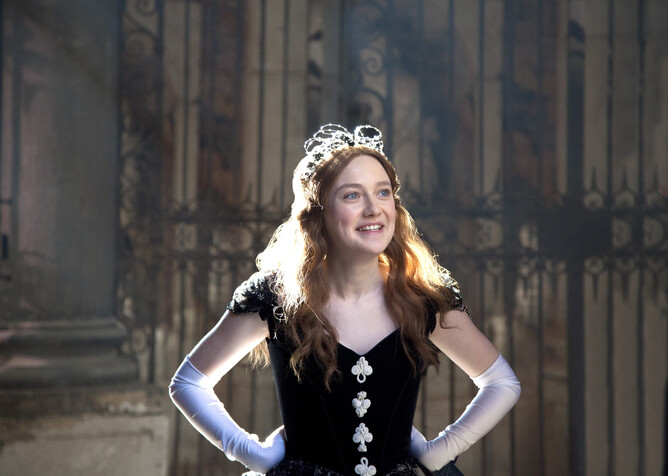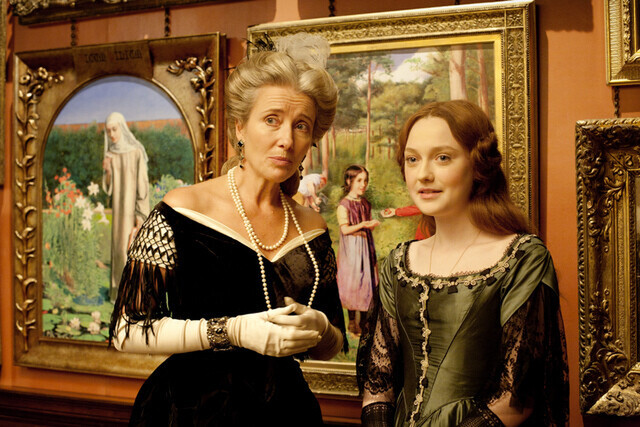Britflicks' Alexa Dalby reviewed EFFIE GRAY back in 2014 when the film was originally released.
Emma Thompson’s first solo original screenplay puts a feminist spin that’s almost contemporary on the true story of the ill-fated marriage of influential Victorian art critic and artist John Ruskin and the beautiful, teenage Effie Gray, daughter of family friends.
As Effie, American Dakota Fanning (with an excellent English accent) has perfect pre-Raphaelite features. Just a flick of her eyes reveals her emotions. Only 19, she marries family friend John Ruskin, played by Thompson’s husband Greg Wise. In real life, Ruskin was then 29 and Wise looks rather too mature. Ruskin turns up too in Mike Leigh’s Mr Turner, screening at the London Film Festival on 10 October, the same day Effie Gray is released, as an affected and precious art critic, but nearer his real age.
In flashback, there are hints of what we would now describe as his grooming of Effie as a child. He marries her at her home in Scotland and hurries her back to London, where he lives with his parents, who have brought him up to become a cerebral prig, devoted to indulging his self-absorption. They are portrayed here as rich but social climbing (Julie Walters as the possessive mother-in-law from hell and conformist paterfamilias David Suchet) in their oppressive Denmark Hill mansion. Here, there’s another interesting crossover with Mr Turner. Ruskins’ parents buy Effie one of Turner’s paintings as a wedding present and in Mr Turner we see Ruskin and his father in Turner’s studio buying it.
On their wedding night Ruskin apparently found something about Effie so ‘disgusting’ that he was never able to consummate their marriage.
On their wedding night Ruskin apparently found something about Effie so ‘disgusting’ that he was never able to consummate their marriage. This mystery has intrigued people for years, and has given rise to numerous novels and a stage play. Was it hypocrisy? His aesthetic mantra was that artists should paint what they see, but was he unable to cope with a real woman who did not resemble the classical statues and paintings he was familiar with? We never see the secret. His reasons are never discussed and as a result the couple became progressively estranged. Effie is in effect superfluous in that environment and she starts to sicken, but he is so wrapped up in his work he hardly notices.
We see Effie’s claustrophobic marriage close round her like a trap and, as her misery makes her ill, we wonder how she will escape from her prison. Ruskin is presently unsympathetic. He goes out of his way to push Effie in the path of potential lovers, apparently to make her seem the guilty party. First, she socialises alone whilst on a trip to Venice where Ruskin is writing his book, her normal happy, high-spirited behaviour prompting gossip. Then, crucially, he asks his protegee, young artist John Everett Millais, one of the new pre-Raphaelite movement that is starting to set the art world on fire (a vibrant Tom Sturridge), who has been commissioned by his parents to paint a suitably high-minded portrait of him, to accompany him and Effie to Scotland, where they all stay together in a small, remote cottage. Millais is everything Ruskin is not – young, handsome, vital, empathetic, warm, human and moved by Effie’s obvious plight. Inevitably the two young people fall (chastely) in love.
Effie endures her miserable marriage from a sense of duty.
Effie endures her miserable marriage from a sense of duty. But, perhaps anachronistically, Emma Thompson presents her as deciding to plan her escape from it, difficult to say the least in an era when married women had no rights or independence. She’s aided by Emma Thompson herself as Lady Eastlake, wife of the president of the Royal Academy, in a juicy role as Effie’s only sympathetic confidante and, ultimately, her rescuer. Perhaps by this, Effie is a precursor of the changing place of women in society, just as the pre-Raphaelite painters were also starting a kind of revolutionary loosening up of the staid art world. In real life, Effie and Millais eventually married and went on to have eight children.
Infused with sumptuous pre-Raphaelite colours by cinematographer Andrew Dunn, the film’s dark and heavy, draped Victorian interiors alternate with glorious Victorian landscapes alive with steam trains and carriages, rain-soaked Scottish highlands and misty lochs. There is a stunning interlude around the canals of Venice and its labyrinth of passages. Effie is presented at first like a princess in a fairy tale, and this is a recurrent image, together with medieval-influenced pre-Raphaelite works such as Millais’ famous painting of the drowning Ophelia, a warning of the fate that could have befallen Effie if she had not escaped.
Dakota Fanning gives an impressive central performance which carries the film. It is peopled with a stellar cast of British actors of different generations – in addition to Greg Wise, there is James Fox as Lord Eastlake; Russell Tovey as George, the Ruskins’ manservant; Sir Derek Jacobi as Effie’s life-saving lawyer and Robbie Coltrane as a no-nonsense Scottish doctor. There’s also a cameo from Claudia Cardinale as a veteran Venetian Contessa. It’s directed by Richard Laxton, known for many TV series and features. The screenplay is detailed and the film’s pace can seem rather deliberate at times. Effie Gray is a beautifully produced, rather bleak film, though it does leave us with the promise of a happier future.
EFFIE GRAY will be released 19th April 2021
www.sovereignfilms.co.uk/sovereign-virtual-cinemas
Alexa Dalby





